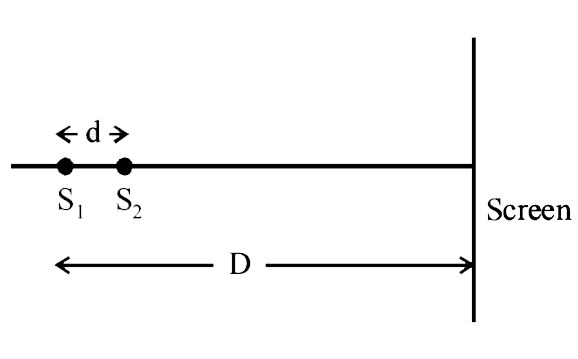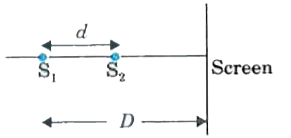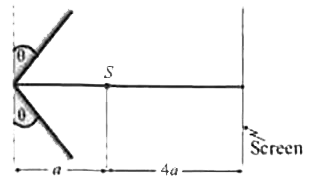In Lloyd's mirror experiment (Fig.) a light wave emitted directly be the source S (narrow slit) interferes with the wave reflected form a mirror M. As s result, an interference fringe pattern is

formed on the screen Sc. the source and the mirror are separated by a distance l=100cm.At a certain position of the source the fringe width on the screen was equal to Δx=0.25mm, and after source was moved away from the mirror plane by Δh=0.60mm, the fringe width decreased η=1.5 times. Find the wavelength of light.
From the general formula
Δx=lλd
we find that Δxη=lλd+2Δh
since d increases tod +2Δh when the source is moved away from the mirror plane by Δh.
Thus ηd=d+2Δh or d=2Δh/(η−1)
Finally λ=2ΔhΔx(η−1)l=0.6μm.
Topper's Solved these Questions
- OPTICSBOOK - IE IRODOV, LA SENA & SS KROTOVCHAPTER - OPTICSEXERCISE - Diffraction Of Light
60 Videos
- OPTICSBOOK - IE IRODOV, LA SENA & SS KROTOVCHAPTER - OPTICSEXERCISE - Polarization Of Light
43 Videos
- OPTICSBOOK - IE IRODOV, LA SENA & SS KROTOVCHAPTER - OPTICSEXERCISE - Exercise
2 Videos
- MECHANICSBOOK - IE IRODOV, LA SENA & SS KROTOVCHAPTER - MECHANICSEXERCISE - Mechanics Problems
92 Videos
- OSCILLATIONS AND WAVESBOOK - IE IRODOV, LA SENA & SS KROTOVCHAPTER - OSCILLATIONS AND WAVESEXERCISE - Electromagnetic Waves, Radiation
36 Videos
Similar Questions
In Young's double slit experiment interference fringes 1∘ apart are produced on the screen, the slit separation is (λ=589nm)
View SolutionAn interference pattern is formed on the screen, when light from two different monochromatic sources are allowed to interfere. Then, it is true that
View Solution
Knowledge Check
Two coherent point sources S1 and S2 are separated by a small distance d as shown. The fringes obtained on the screen will be
 ApointsBstraight linesCsemi-circlesDconcentric circles
ApointsBstraight linesCsemi-circlesDconcentric circlesTwo coherent point sources S1andS2 are separated by a small distance 'd' as shown. The fringes obtained on the screen will be :
 Astraigth linesBsemi-circleCconcentric circlesDpoints
Astraigth linesBsemi-circleCconcentric circlesDpointsIn interference pattern, using two coherent sources of light, the fringe width is …… .
Adirectly proportional to wavelength.Binversely proportional to square of the wavelength.Cinversely proprotional to wavelength.Ddirectly proportional to square of the wavelength.
Two coherent sources of light interfere and produce fringe pattern on a screen . For central maximum phase difference between two waves will be
View SolutionAn interference pattern is observed by Young's double slit experiment.If now the separation between coherent source is halved and the distance of screen from coheren sources is doubled, then now fringe width
View SolutionTwo sources give interference pattern which is observed on a screen, D distance apart from the sources. The fringe width is 2 w . If the distance D is now doubled, the fringe width will
View SolutionIn Young's double slit experiment, the distance between sources is 1mm and distance between the screen and source is 1 m . If the fringe width on the screen is 0.06cm , then λ=
View SolutionThere are two plane mirrors. They are mutually inclined as shown in figure. S is a source of monochromatic light of wavelength λ. The reflected beam interfere and fringe pattern is obtained on the screen. If θ is small, the fringe width will be :

View Solution
